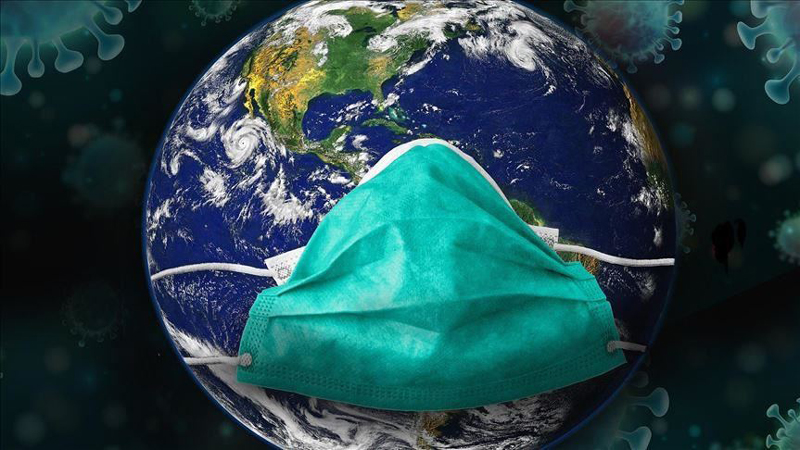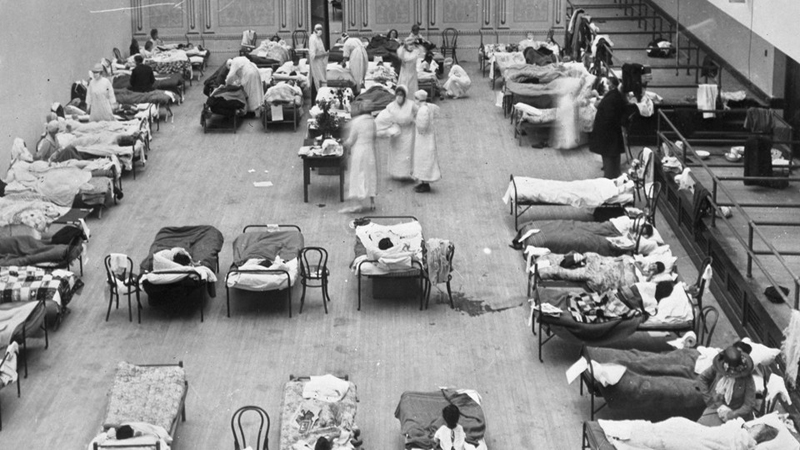
A pandemic causes havoc and alters the human community on large scale. We have dig out the impact of one of the offending pandemic i.e. 1918 Flu Pandemic also called as Influenza Pandemic.

Pandemic causes devastation in the various fields, such as economic downfall, scarcity of food, increasing the already increasing inequality and most importantly causing a pounce of depression.
Introduction to Influenza Pandemic
The 1918 flue pandemic, also known as the Spanish flu. It was the most severe pandemic in the history which caused by an outbreak of the influenza type A virus, subtype H1N1. Unlike other influenza epidemics that mainly affect children and the elderly, But young, fit & healthy adults, and also animals including dogs, cats etc also affected in this pandemic. It is considered the most disastrous pandemic in human history since in just one year it killed around 20 to 40 million people across globe.
The disease was reported for the first time on March 4, 1918, at Fort Riley (Kansas, United States) although already in the fall of 1917 there had been a first herald wave in at least fourteen military camps. Traditionally it was located in the United States, specifically, in Haskell County, in April 1918, and at some point, in the summer of that same year. The first confirmed case of the mutation occurred on August 22, 1918, in Brest, the French port through which half of the Allied US troops entered World War I.
History of 1918 Flu Pandemic
Traditionally, the chef Gilbert Michell of Fort Riley in Kansas, admitted on March 4, 1918, has been considered “sick zero”. Hours later, dozens of cases were already counted, to the point of having to set up a hangar for the sick, since the hospital did not have sufficient capacity. However, researchers such as Santiago Mata collect reports and publications stating that very virulent outbreaks of influenza had already been detected months before and not in Kansas, but almost all, if not all, the US military camps enabled to send soldiers to Europe.
The flu had been substantially increasing its death rate for some time. Thus, MATA collects the data of 18,886 deaths from influenza in 1916, a 2.6% mortality rate when seasonal influenza showed an average mortality of 0.056% in the United States. This mortality rate in 1916 was already an increase of 65% compared to 1915 and in turn, the mortality of that year was 75% more than that of 1914.
However, these figures are obtained from the general population. It affects many more children and especially older people, up to 95% of the seasonal deaths belong to this group. But in December 1917 a surprising data emerged at Camp Greene, near Charlotte (North Carolina), where there are 20 deaths of a total of 565 flu patients, all of them were young men.
Symptoms Detected at Camp Greene
Santiago Mata collects the descriptions provided by the medical captain Herman Elwyn on the patients who appeared in December 1917 and subsequent months. These symptoms were:
- Greyish face
- Moderately dilated pupils;
- Fever exceed 39 degrees;
- Shallow and rapid breathing;
- Extreme exhaustion.
- Between four and six hours after the first symptoms, the patient’s lungs were already beginning to secrete excess fluid.
- Between 12 and 18 hours, after the previous symptoms appeared, there was a worsening with more pulmonary fluid, more dyspnoea, increased pupillary dilation, prostration, profuse sweating, increased fever.
- If the symptoms did not subside, death occurred between 24 and 48 hours after the worsening occurred.
Mortality:
The death rate of the 1918-1920 pandemic is unknown, but authors such as Juan Carlos Losada (2012) estimate that 10% to 20% of those infected died. Its morbidity rate could reach up to half of the world population, but other sources raise it to two thirds, this fatality rate means that between 3% and 6% of the world population died, but it varies greatly with populations, as indigenous peoples of the Pacific or the Arctic lost up to 90% of their population.

The flu could have killed 25 million people in the first 25 weeks. Older estimates indicated that between 40 and 50 million people died. However, many countries did not have a health service capable of collecting reliable data, and many of the deaths were not counted; For this reason, current estimates mention between 50 and 100 million victims.
Spain was one of the most affected European countries with about 8 million people infected in May 1918 and more than 200,000 deaths (even though official figures reduced the victims to “only” 147,114 people).
It is estimated that in China 30 million people died, reaching a mortality of 40% of the population in some areas. In the Chinese Army, at least 35% of the troops that fell ill died. In the United States, about 28% of the population suffered from the disease, and between 500,000 and 675,000 people died.
In the United Kingdom, 250,000 died, in Spain, 200,000 (1% of the population). population), in Colombia approximately 3,000 (mainly in the department of Boyacá), in Venezuela 25,000, in Argentina officially 14,997, although it is estimated twice as much, in Paraguay about 2,000 people, in France 400,000 and Italy a similar number.
In British India, 10 to 17 million died. Estimates for Africa Sub-Saharan countries report 1.5 to 2 million victims. In Alaska in the Inuit town of Fairbanks of 80 inhabitants, 78 died in just one week, and in South Africa, entire communities died, in Australia, about 80,000 people died and in Fiji, 30% of the population died in just two weeks, while in Western Samoa 40%, in Chile 43,113 people died.
Treatments:
The world population is immunized for flu strains that are common but in the face of very aggressive mutations or new strains, it may be very defenceless. In 1918 there were no vaccines. the primary effective studies began in 1931 and within the Forties, the U.S. Army developed the primary approved inactivated contagious disease vaccines, that were employed in war II.
In the face of the global pandemic of 1918, no account is taken of how many miracle remedies were announced. But doctors also used all the resources at their disposal: from the ancient art of bleeding patients, administering oxygen, to supplying quantities of huge amounts of aspirin.
An attempt was made to develop new vaccines and serums, primarily against various types of pneumococci and what are now called Haemophilus influenza, a name derived from the fact that it was originally considered the etiologic agent. But only one therapeutic measure showed any success: the transfusion of blood from recovered patients to new victims; a strategy that is being retested in the 2020 COVID-19 disease.
Difference Between Coronavirus & Swine Flu
What is H1N1 Influenza or Swine Flu?
On the other hand, H1N1, or swine flu, is a highly contagious type of influenza A virus in humans that causes shortness of breath. It originated in Mexico in 2009, after which the infection spread to 74 countries. Because the symptoms of swine flu are similar to the common flu, it spreads like the common flu.
Symptoms include:
- High fever
- Headache
- Sore throat
- Shiver
- Discomfort
As a result of the initial symptoms of swine influenza and CoVID-19 area unit terribly similar, laboratory tests area unit needed to substantiate the character of the malady.



